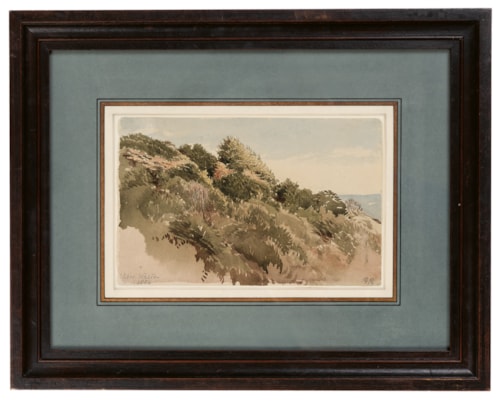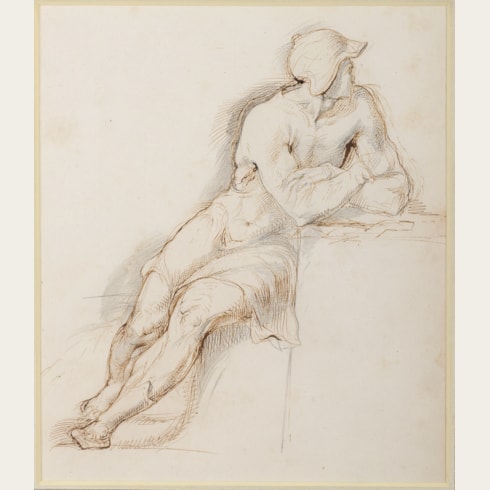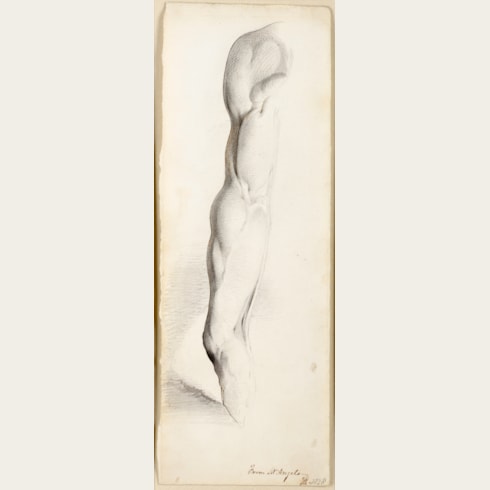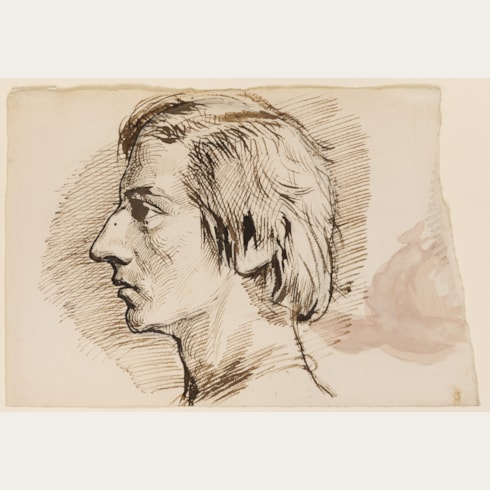George RICHMOND
(Brompton 1809 - London 1896)
Landscape near Walton
Watercolour, over traces of an underdrawing in pencil.
Signed with the artist’s initials GR in pencil at the lower right.
Inscribed and dated near. Walton / 1854 in pencil at the lower left.
135 x 213 mm. (5 1/4 x 8 3/8 in.)
Signed with the artist’s initials GR in pencil at the lower right.
Inscribed and dated near. Walton / 1854 in pencil at the lower left.
135 x 213 mm. (5 1/4 x 8 3/8 in.)
Dated 1854 and likely drawn on a page from a small sketchbook, this watercolour view of dunes by the sea was probably drawn in September or October of that year, when George Richmond is known to have taken a holiday in the town of Walton; probably the small seaside resort of Walton-on-the-Naze in Essex, on the east coast of England. The present sheet would appear to depict part of the Naze, a marshy headland projecting into the North Sea, just to the north of the town, which today contains a small nature reserve.
This sketch is comparable, in stylistic terms, with a handful of other landscape watercolours by the artist, such as a study of a large tree which remained in the possession of Richmond’s descendants until 2001, or a view of Norbury Woods, Surrey of 1860, in the Fitzwilliam Museum in Cambridge. Also similar is a watercolour study of trees in the forest of Mickleham Downs in Surrey, dated 1848, in the Pilkington Collection at Eton College in Windsor, and A Field near Margate, dated 1850, formerly in the Oppé collection and now in Tate Britain in London.
This sketch is comparable, in stylistic terms, with a handful of other landscape watercolours by the artist, such as a study of a large tree which remained in the possession of Richmond’s descendants until 2001, or a view of Norbury Woods, Surrey of 1860, in the Fitzwilliam Museum in Cambridge. Also similar is a watercolour study of trees in the forest of Mickleham Downs in Surrey, dated 1848, in the Pilkington Collection at Eton College in Windsor, and A Field near Margate, dated 1850, formerly in the Oppé collection and now in Tate Britain in London.
A disciple of Willam Blake and a close friend of Samuel Palmer, George Richmond formed - with Palmer, Edward Calvert and other followers of Blake - a small group who called themselves ‘The Ancients’. The only member of ‘The Ancients’ who received a conventional academic training, Richmond entered the Royal Academy Schools in December 1824, at the age of just fourteen, and there studied under Henry Fuseli. It was while he was at the Academy Schools that he first showed himself to be an accomplished and gifted draughtsman. Between 1824 and 1828 Richmond often joined Blake, Palmer, John Varley and others at John Linnell’s Hampstead home to draw from nature, as he also did with Palmer at Shoreham in Kent for several weeks in 1827. After his marriage in 1831, Richmond began working primarily as a portrait painter, quickly achieving a considerable measure of success. Although much influenced by Michelangelo and Italian art of the Renaissance, it was not until 1838 that Richmond was able to visit Italy, when he travelled with Palmer to Rome. In the 1840s he became friendly with John Ruskin, of whom he produced two portraits, exhibited at the Royal Academy in 1843 and 1857; the second of these was later engraved. Elected to the Royal Academy in 1866, Richmond’s stature in the London art world was such that he was twice offered the directorship of the National Gallery, which he twice declined. It is as a portraitist that Richmond is best known today, and which accounts for the bulk of his extant oeuvre as a painter. As his biographer Raymond Lister has noted, ‘Richmond was in fact at his greatest as a portrait painter. Despite yearnings to express himself in other ways, despite his early promise as a visionary painter, it is in portraiture that his true stature is to be seen.’
Provenance
James Mackinnon, London, in 2015
Matthew Rutenberg, New York.
Matthew Rutenberg, New York.









